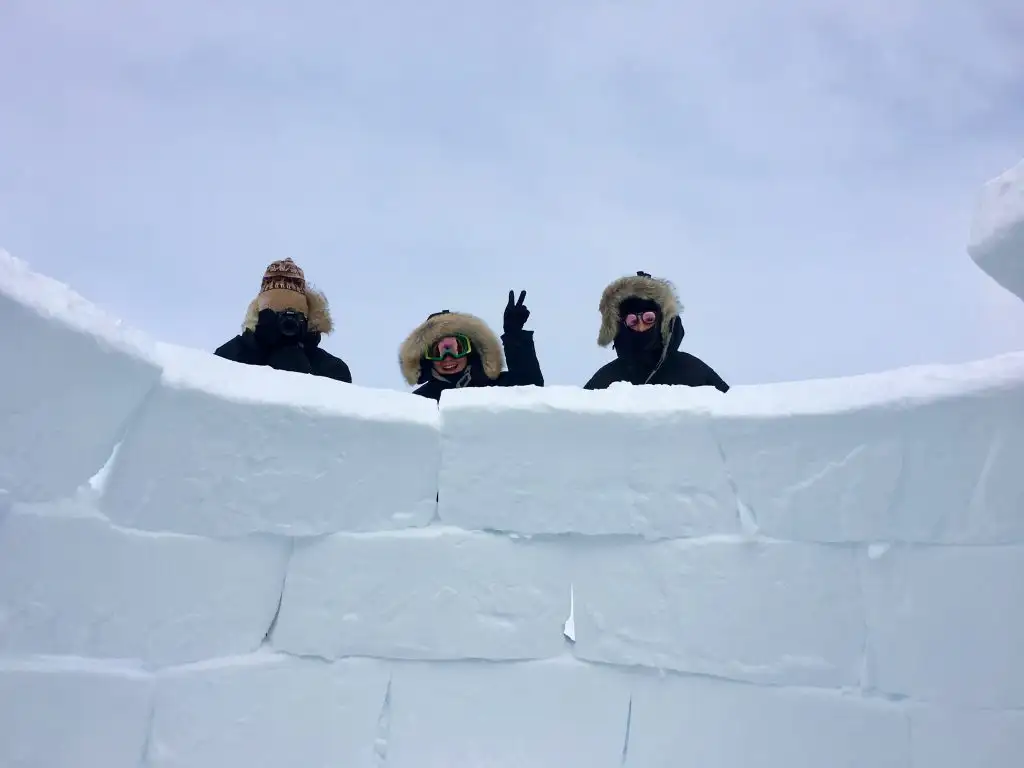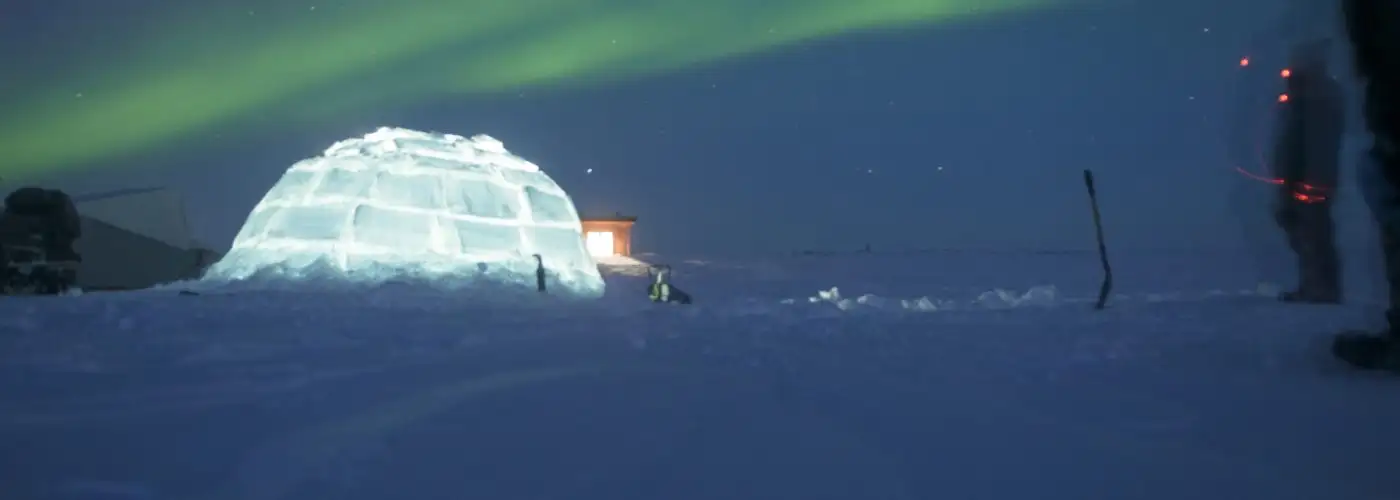Waking up to filtered light creeping through the ice blocks surrounding me was a welcome change from my normal blaring phone alarm. No, I wasn’t inside a freezer. The ice blocks were stacked ever so carefully around me, like a delicate work of frozen art.
The previous day I’d traveled by dogsled a few miles away from any civilization to embark on the intrepid adventure of building and sleeping in an igloo. I was in the middle of a frozen tundra, just outside the Inuit community of Puvirnituq in Quebec, Canada.
What Arctic Tundra Travel Is Really Like

Out here the weather is constantly changing—one minute a partly cloudy blue sky, the next whipping winds with circulating snow drifts.
To the people of Puvirnituq, the harsh winter conditions are a way of life. “We have to be able to work together to survive,” says Aliva Tulugak, a storyteller and a leader and member of the community’s co-op organization for over 30 years. And that’s exactly what they do. Living in the “Far North” is a way of life, and it’s a way of life the Inuit treasure.
Nunavik, the northernmost region of Quebec, is home to 14 Inuit communities. Getting here is no easy feat: The closest highway ends 500 miles away in the community of Chisasibi. But the region offers incredible and natural wildlife sightings like caribou, Arctic wolves, musk ox, and polar bears, as well as authentic ice fishing and dogsledding experiences, the chance to see the northern lights, three (soon to be four) untouched national parks, and a truly off-the-grid experience.
I traveled to the region with Inuit Adventures, a tour company that has led tours to the region since 2005. The company’s mission is clear: It works for the Inuit people, and only hires and works with local guides. I felt the authenticity the moment I met my group’s guides. The land in Nunavik is their home and my group trusted them to share their traditions, culture, history, survival skills, and amazing way of life.
Arctic Tundra Travel Lessons
Peter Boy Ittukallak, a famed soapstone carver; his brother, Inukpak; and his son, Eric, led us out “on the land” with their dogsled team. Peter Boy and Eric just placed second in Ivakkak, an annual dogsledding competition in Nunavik. They also breed huskies, which were nearly extinct because of government assimilation programs in the 1970s.
Thanks to locals like Peter Boy and his son, as well as the Canadian Government’s Truth and Reconciliation Commission, traditions are slowly coming back to Nunavik after the dark period of the government’s attempt at assimilation. And the Inuit people want to share their surviving traditions with those willing to hear it. While the communities don’t see a lot of tourists, especially in winter, there are plenty of activities for adventurous travelers and those who want to travel to learn.
The main activity on my tour was building an igloo with Inuit guides and then sleeping in it. To spend 24 hours on the frozen tundra is not something any tourist can just go and do. Days of preparation, including provisions for food, shelter, and safety, were under way before we left the main town. And once we left, we were not to come back until morning.
https://www.instagram.com/p/BwDQfTug8sl/
Peter Boy and our guides got to work on the two igloos the second we arrived. First, they had to find the ideal snow to use for the ice blocks. The snow can’t be too soft, too wet, or too packed, or else it will collapse. Once Peter Boy was happy with a spot, he got to slicing out the bottom ice blocks. Unsure of whether to help him or watch and learn, the group waited to get involved.
Within about an hour, we were all doing something; some helped lift the heavy blocks (each block weighs about 45 pounds), others packed in snow to seal cracks, and others took turns making tea. Peter Boy never told us what to do; we just went in to help where we could. Building an igloo big enough to sleep 10 people was going to take a lot of time. Plus, the dogs needed to be anchored in a spot to sleep, and we all needed to eat—which meant ice fishing. After taking turns banging a metal rod on the five-foot-thick ice, we broke through to the ocean. Within seconds Eric caught a cod, and then seven more. We now had plenty of food and made fish stew on the propane stove back at camp.
Building an igloo is an art form. Each block is cut, shaved down, and then purposefully placed, and each wedge that fills the space in between is planned with care. The Inuit people lived in igloos and used them as their main form of shelter in the winter until housing was established in Puvirnituq. Peter Boy was even born in an igloo. Throat singing, a unique way of using your throat muscles and diaphragm, was invented when women were left alone in their igloos while the men went hunting. To pass the time, they developed it as a game and members of the community now travel around the world to teach this fascinating form of singing.
While modern conveniences like TVs, Wi-Fi, heat, and bathrooms—you’re on your own in the frozen tundra when it comes to relieving yourself during an overnight in an igloo—mean that the Inuit now prefer to live in homes located in town, many enjoy spending a night or two out here. “Best sleeps are out here,” said Peter Boy when we awoke in the morning lying on the snow-covered ground, eight people stacked head to toe. By teaching his son and other younger members of the community how to build igloos, dogsled, carve, and hunt, Peter Boy is keeping these traditions alive.

Everything I learned in this story was from my time spent “on the land” talking, working, and learning from our Inuit guides. Losing my sense of time and letting nature literally take its course was the experience I’ll always treasure from spending 24 hours on the Arctic tundra.
After our time on the land, Peter Boy invited us to a community feast that celebrated the winners of the previous week’s dogsled competition. We walked into a gymnasium with frozen raw meat, like caribou, seal, and fish on the floor under a paper placemat with families gathered around the food eating it with their bare hands. It was an honor for my group to be invited to this tradition and Peter Boy did so only after he felt like we truly appreciated our experience out on the land. It was a bond that nature had created.
Arctic Tundra Travel Tips
I traveled to the region with Inuit Adventures during the end of the winter season. If you’re looking for cold but not unmanageable temperatures, as well as winter activities like seeing the northern lights, ice fishing, dogsledding, cross country skiing, snowmobiling and more, then March or April is a good time to go. During summer, Nunavik experiences the “land of the midnight sun,” so you have some days without any darkness. Summer is a great time for above-freezing temperatures, hiking, kayaking (an Inuit invention), and camping in the national parks, as well as the prime time to spot polar bears and other wildlife.
More from SmarterTravel:
- The 7 Best National Parks to Visit in Winter
- The Thinnest, Warmest Winter Clothes for Packing
- 7 Must-Have Travel Toiletries for Dry Winter Weather
Ashley Rossi was hosted by Quebec Original on her trip to Nunavik. Follow her on Twitter and Instagram for travel tips, destination ideas, and off the beaten path spots.
We hand-pick everything we recommend and select items through testing and reviews. Some products are sent to us free of charge with no incentive to offer a favorable review. We offer our unbiased opinions and do not accept compensation to review products. All items are in stock and prices are accurate at the time of publication. If you buy something through our links, we may earn a commission.
Related
Top Fares From
Today's Top Travel Deals
Brought to you by ShermansTravel
Shop and Save with Country Inns...
Patricia Magaña
 Hotel & Lodging Deals
Hotel & Lodging Deals
$229 -- Chicago: Discounted Rates and...
Francesca Miele
 Hotel & Lodging Deals
$229+
Hotel & Lodging Deals
$229+
$188 -- Honolulu: Save on Oceanview...
Abigail Lamay
 Hotel & Lodging Deals
$188+
Hotel & Lodging Deals
$188+




